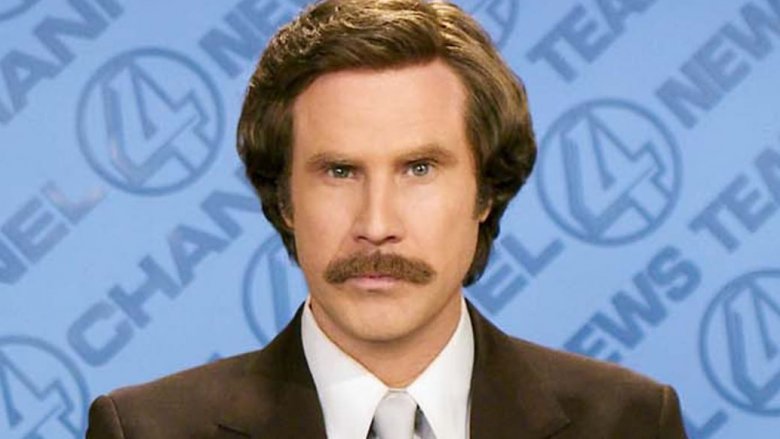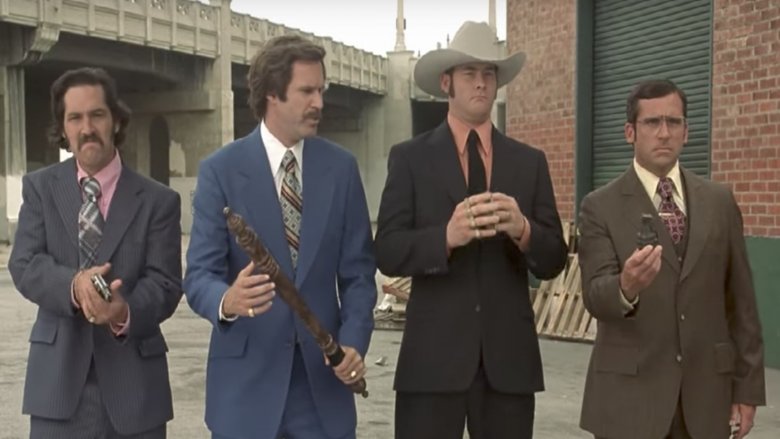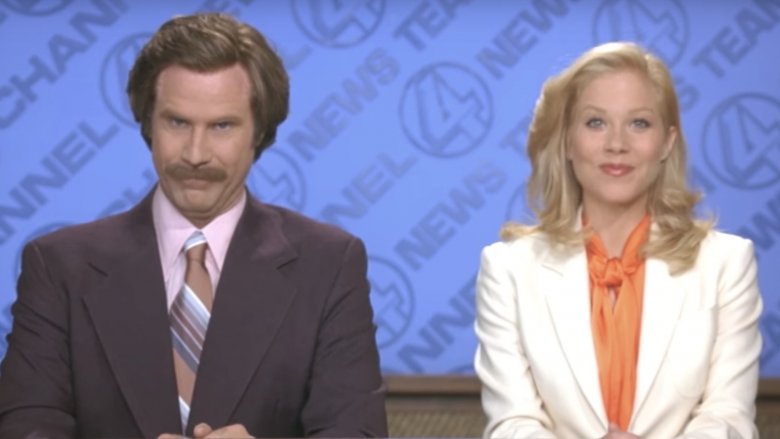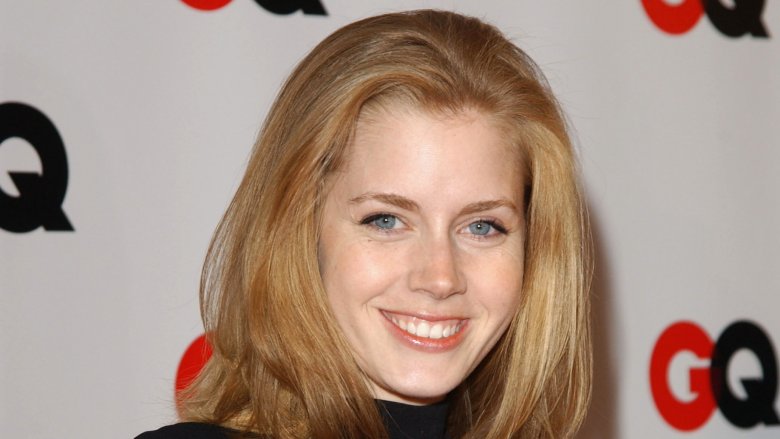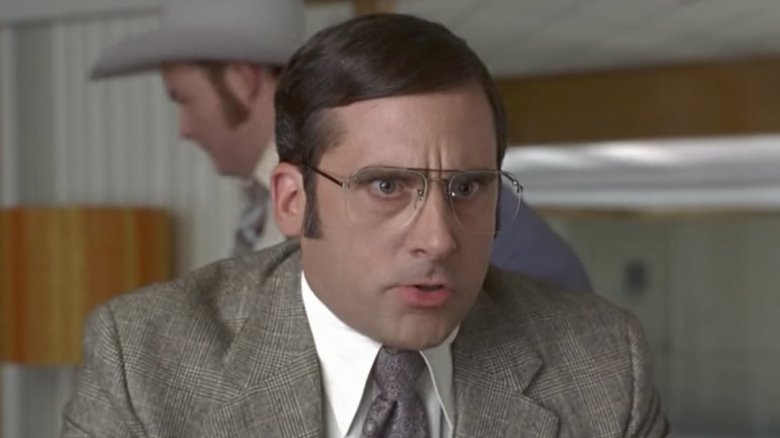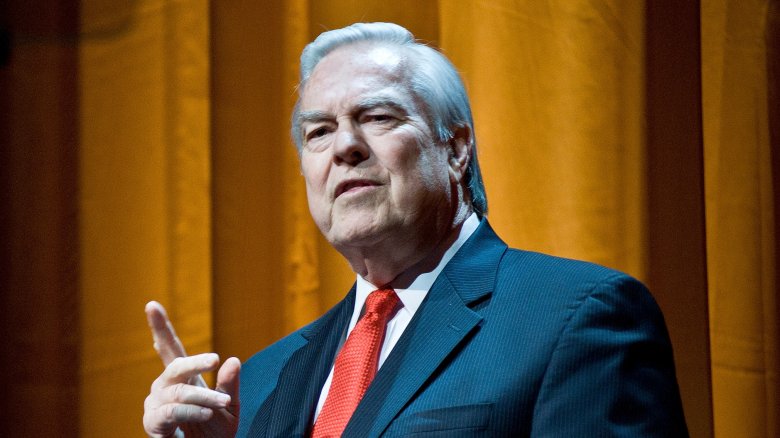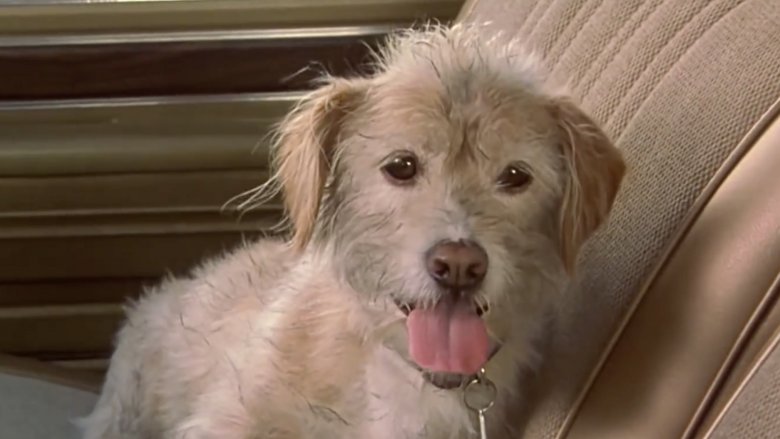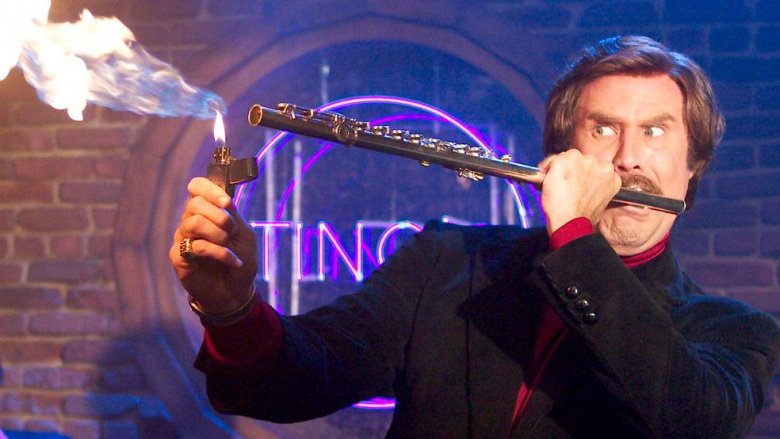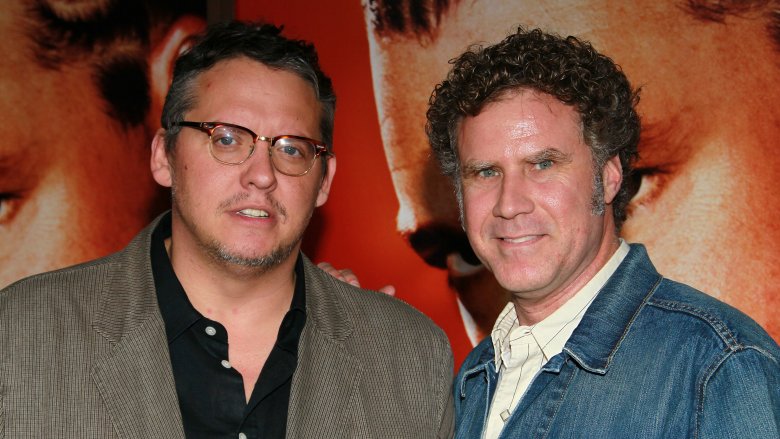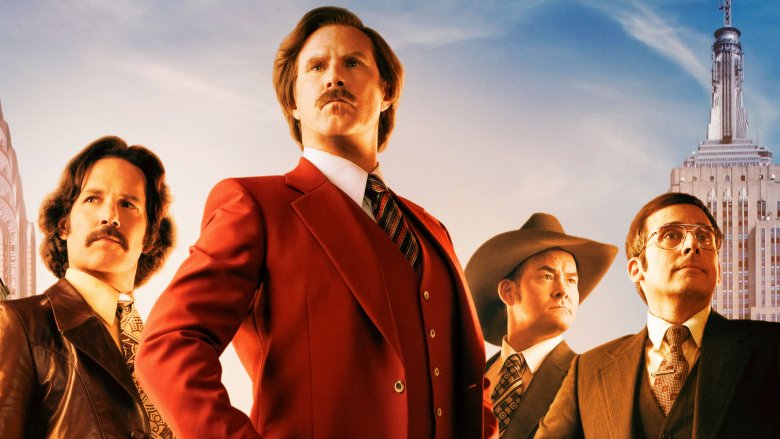The Untold Truth Of Anchorman
The story of a male chauvinist news anchor and his local news cronies in '70s San Diego, Anchorman: The Legend of Ron Burgundy launched one of Will Ferrell's most hilarious and ridiculous characters, along with countless catchphrases like "Sixty percent of the time, it works every time," "Cannonball!" and "I love lamp." Comedy all-stars Paul Rudd, Steve Carell, David Koechner, and Christina Applegate rounded out the cast of the 2004 hit, which was conceived by Adam McKay (who also directed) and Ferrell (who's called it his favorite of his own movies). Break out of your "glass case of emotion," stay classy, and enjoy these little-known facts about Anchorman. Don't act like you're not impressed.
The original script involved plane crashes and orangutan attacks
While Adam McKay and Will Ferrell were both working at Saturday Night Live—McKay as a writer, Ferrell as a cast member—the two wrote a wacky screenplay about car salesmen called August Blowout. It was never made, but it made the rounds in Hollywood, eventually crossing the desk of Boogie Nights and Magnolia writer/director Paul Thomas Anderson—who, when he joined SNL for a week as a guest writer during the 2001-'02 season, told McKay and Ferrell he'd do whatever he could to help them get their next script produced.
Thus emboldened, McKay and Ferrell wrote the first version of Anchorman, which has very little in common with the movie that eventually wound up onscreen. The plot: While flying with his news team to a convention in 1976, Ron Burgundy convinces the pilot to let him take the controls, and he crashes into the mountains. During the crash, the news team's aircraft clips a cargo plane carrying orangutans and throwing stars. "So throughout the movie we're being stalked by orangutans," said Ferrell, "who are killing, one by one, the team with throwing stars."
The characters were inspired by real-life news anchors
The eventual plot of Anchorman, concerning rampant sexism in the 1970s newsroom, was inspired by the difficult rise of NBC News anchor Jessica Savitch. As one of the first major female news anchors, she encountered major resistance—including from Mort Crim, her co-anchor at a Philadelphia station in the '70s. Watching a documentary about Savitch, Ferrell was struck by Crim's recollection of that period—particularly his admission that "I was a real male chauvinist pig. I was not nice to her."
As for Ron Burgundy's well-coiffed, mustached appearance, Ferrell won't say if that's based on any one anchor in particular. The character's look is so synonymous stereotypical '70s news anchors that many people have asked him if Ron Burgundy is based on their local newsman of yore. One time an actual San Diego newscaster named Harold Greene approached Ferrell on the street in Beverly Hills and straight up asked him if he was the inspiration for Ron. Ferrell denied it with a chuckle, to which Greene replied, "There's an old saying in the news game: 'Yeah, right.'"
Some surprising stars auditioned
Director Adam McKay auditioned several women for the role of glass ceiling-shattering news anchor Veronica Corningstone before awarding it to Christina Applegate. Leslie Mann tried out, but McKay thought she lacked the "'50s wholesome thing" he sought. Future Oscar nominee Maggie Gyllenhaal didn't make the cut either; as McKay said, he expected her to "win an Academy Award someday, and you don't put Meryl Streep in a comedy." The other also-ran was a then little-known Amy Adams, who McKay described as "awesome" but lamented that she "looked like she was only 18."
According to McKay, the role of the enigmatic and incredibly stupid weatherman Brick Tamland came down to two choices: Steve Carell and an another, unnamed actor. But former Brat Packer James Spader (Pretty in Pink) demanded McKay give him a shot, too, saying it was one of the funniest characters he'd ever read, and that he would "do anything to get this role"...short of actually auditioning.
Paul Rudd, however, loved the script so much that he actually was willing to audition. He ultimately won the role of sex-obsessed reporter Brian Fantana over Mr. Show and Better Call Saul star Bob Odenkirk, as well as Ron Livingston from Office Space.
The studio wanted Brick Tamland out of the movie
He's an undisputed fan favorite, but studio execs thought bizarre, creepy Brick was totally unnecessary to the film. Especially problematic was how Brick didn't seem to fit into any particular scene—and in a speech at Columbia University, McKay acknowledged that the executives had a point. "If you read it on the page," he mused, "it reads insane." But being pointless and weird was kind of the point: to prepare Steve Carell for the part, McKay told him, "You have no rules. You can literally walk out of the scene if you want."
The narrator had major reservations
Lending Anchorman a sense of mock importance is the narration provided by Bill Kurtis, veteran newsman and narrator for TV series like Investigative Reports and Cold Case Files. McKay sent Kurtis the script, and he thought it was so hilarious that he agreed to do it.
"Then, of course," Kurtis told the Chicago Tribune, "I got scared." He worried that the movie would flop, or that doing it would diminish his journalistic integrity. Kurtis asked a friend—who just so happened to be Ghostbusters and Groundhog Day co-writer Harold Ramis—for advice. Ramis told Kurtis that nobody ever knows if a movie will work until it's done, but that McKay and Ferrell seemed smart and that he just ought to "jump." Jump he did.
Kurtis recorded his lines in a Los Angeles studio, overseen by producer Judd Apatow. The session went fine until the script called for Kurtis to say a line that had the word "penis" in it. "I wouldn't say it," Kurtis recalled. "I had no idea how this film would turn out. If it's an embarrassment, here I am saying 'penis' in it...but now, I would certainly do it! Over and over again!"
The doggone bizarre reason it was almost rated R
Despite some very adult material—including a scene in which Ron walks around for well over a minute with the front of his pants tented—Anchorman earned a PG-13 rating, guaranteeing that a wider audience could see it. But Anchorman earned an R rating—because of excessive dog genitalia.
Ron's loyal dog Baxter apparently showed off his business a bit too prominently in an early cut of the film. According to McKay, the Motion Picture Association of America has a rule of "contextual uncertainty," which states that if a movie contains more than five seconds of close-up shots of male genitalia—including animal genitalia—it automatically gets an R rating. McKay had to go back to the editing bay and cut out the dog bones to get that PG-13.
Who really played the jazz flute?
While running across nightclub tables and sliding underneath the doors of bathroom stalls, Ferrell really looks like he knows what he's doing when he's playing "jazz flute." Alas, it's not really him playing the instrument with such mastery, verve, and sensuality. For that, the production hired a professional to lay down the tracks. Katisse Buckingham's flute is what's actually heard in the movie. He's best known for playing on Dr. Dre's landmark 1992 album The Chronic.
There's a semi-secret sequel
Despite extensive rewrites, Anchorman's script proved entirely too long, and the filmmakers had to remove an entire subplot about a group of bank robbers (played by Maya Rudolph, Kevin Corrigan, and Chuck D) from an extremist group called the Alarm Clock. Members of the Channel 4 news team cross paths with the Alarm Clock, and even get kidnapped, but it was just too much material, and it didn't gel with the rest of the movie. However, it was later cobbled together and released on DVD as an unofficial sequel or "lost movie" called Wake Up, Ron Burgundy!
The DVD commentaries are bizarre
For film buffs, listening to a cast and/or creative team discuss their work on a DVD commentary track can add a whole new dimension to the viewing experience—but for the team behind Anchorman, the commentary tracks were just another place to squeeze in even more absurd comedy. The Anchorman commentary rounds up an eclectic ensemble that includes Ferrell, Koechner, and McKay, as well as—for some strange reason—soul legend Lou Rawls. When it came time to record the partial commentary track for Wake Up, Ron Burdundy!, McKay did it in character as self-absorbed film producer "Aaron Zimmerman," who spends an inordinate amount of time arguing with Ferrell over the extent of his involvement in the movie.
Why Anchorman 2 took so long
Nine years after Anchorman's 2004 premiere, a sequel finally arrived in theaters—an extended delay that initially happened because McKay and Ferrell didn't want to make a sequel.
"For the longest time, we were very anti-sequel," Ferrell told Entertainment Weekly. "But the more we talked about it, the more we started getting excited."
They may have been excited, but their enthusiasm wasn't necessarily contagious at first. McKay and Ferrell pitched it in 2008, but the studio wasn't interested; the next year, the duo seriously considered doing it as a Broadway musical, only to realize that it would probably take them several years to get it off the ground. The cast and crew moved on to other projects, but several years later, Ferrell and McKay decided to pitch Anchorman 2 to Paramount one more time—and this time, the studio said yes (partly because the cast agreed to take pay cuts).
